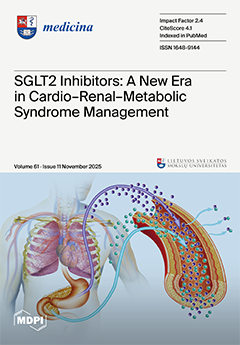Background and Objectives: Familial type 1 diabetes (FT1D) represents a distinct subgroup of T1D potentially influenced by shared genetic and environmental factors. Data from Middle Eastern populations—where both T1D incidence and consanguinity are high—remain limited. This study aimed to determine the prevalence of FT1D and to compare the clinical, metabolic, and immunological features of FT1D with non-familial T1D (NFT1D) among children and adolescents in Saudi Arabia.
Materials and Methods: A retrospective analytic study was conducted among 987 individuals diagnosed with T1D before 18 years of age and followed at the Jazan Endocrinology and Diabetes Center between 2015 and 2023. Participants were categorized as FT1D if they had at least one affected first-degree relative. Demographic, clinical, and biochemical data—including autoantibody profiles, associated autoimmune diseases, glycemic indices, and acute complications—were compared. Multivariate regression analyses were performed to assess independent associations after adjustment for age at diagnosis, sex, and parental consanguinity.
Results: FT1D accounted for 19.5% of all T1D cases, with siblings being the most affected relatives (11.3%). FT1D patients were diagnosed at a younger age (8.2 ± 3.4 y vs. 9.3 ± 3.7 y;
p = 0.001), had lower HbA1c (10.7 ± 1.5 vs. 12.0 ± 1.5;
p < 0.001), less DKA at presentation (33.9% vs. 49.7%;
p < 0.001), and fewer ICU admissions (13.5% vs. 20.8%;
p = 0.023). In adjusted models, FT1D remained independently associated with lower odds of DKA (OR = 0.54, 95% CI 0.39–0.76,
p < 0.001) and ICU admission (OR = 0.58, 95% CI 0.37–0.92,
p = 0.019), and with higher odds of extra-pancreatic autoantibody positivity (OR = 1.78, 95% CI 1.21–2.61,
p = 0.003) and anti-tissue transglutaminase antibodies (OR = 1.64, 95% CI 1.05–2.56,
p = 0.031).
Conclusions: FT1D constitutes a considerable proportion of pediatric T1D in Saudi Arabia and is characterized by earlier onset, milder metabolic decompensation at diagnosis, higher consanguinity, and higher likelihood of associated extra-pancreatic autoimmune diseases. Despite these differences, short-term glycemic outcomes remain similar to non-familial cases. These findings emphasize the need for family-based screening, genetic counseling, and early detection programs in high-risk populations.
Full article






